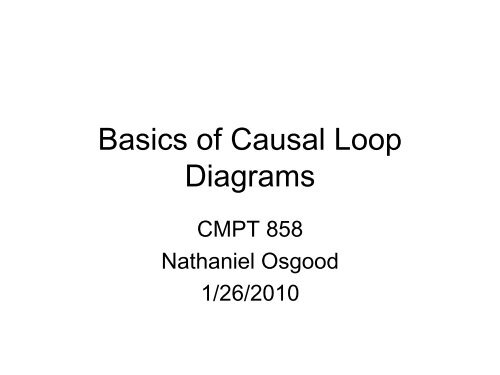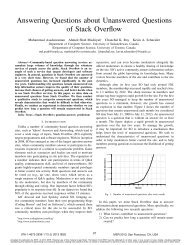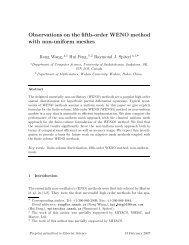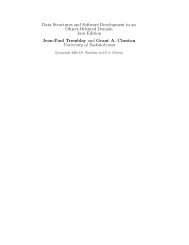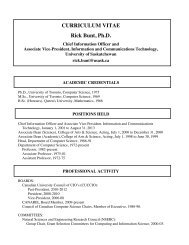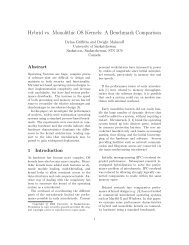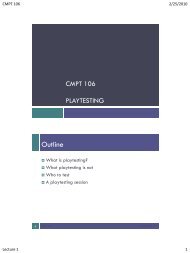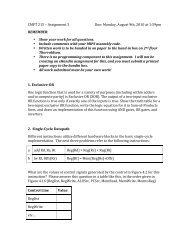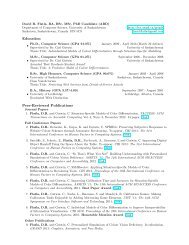Causal Loop Diagram - the Department of Computer Science!
Causal Loop Diagram - the Department of Computer Science!
Causal Loop Diagram - the Department of Computer Science!
You also want an ePaper? Increase the reach of your titles
YUMPU automatically turns print PDFs into web optimized ePapers that Google loves.
Consider A → B• We are reasoning here about causal influences– The changes on B caused by changes in A• This is not merely an associational relationship• This should not merely be a matter <strong>of</strong> definition• Notion <strong>of</strong> “Increase”• Must Clearly Distinguish– “if X were to INCREASE, would Y increase or decreasecompared to what it would have o<strong>the</strong>rwise been ”?• “if X were to INCREASE, would Y increase ordecrease over time”?– i.e. “if X were to INCREASE, would Y rise or fall over time”?
<strong>Causal</strong> Pathways• We can reason about <strong>the</strong> influence <strong>of</strong> onevariable and ano<strong>the</strong>r variable by examining <strong>the</strong>signs along <strong>the</strong>ir causal pathway• Two negatives (whe<strong>the</strong>r adjacent or not) will actto reverse each o<strong>the</strong>r– Consider A → - B → - C• An increase to A leads B to be less than it o<strong>the</strong>rwisewould have been• B being lower than it o<strong>the</strong>rwise would have been causesC to be higher than it o<strong>the</strong>rwise would have been• (compared to what it o<strong>the</strong>rwise would havebeen)
Tips• Variables will <strong>of</strong>ten be noun phrases• Variables should be at least ordinal• Links should have unambiguous polarity• Indicate pronounced delays• Avoid mega-diagrams• Label loops• Distinguish perceived and actual situation• Incorporate targets <strong>of</strong> balancing loops• Try to stick to planar graphs• <strong>Diagram</strong>s describe causal not casual factors!
Ambiguous Link• Ambiguous Link: Sometimes +, sometimes -Food intakeEnergy Surplus+Rate <strong>of</strong> WeightGain• Replace this by disaggregating causalpathways by showing multiple linksFood intake+Calories Taken in+++Basal Metabolism Calories Burrt-Energy Surplus+Rate <strong>of</strong> WeightGain
Example 2• Ambiguous Link: Sometimes +, sometimes–Overtime• Replace this by disaggregating causalpathways by showing multiple links+Work Accomplishedper DayOvertime++FatigueGreater Incorporation <strong>of</strong>Outside Tasks at Work- Efficiency+ Work Accomplished+ per Day+More TimeWorking
Example 3• Ambiguous Link: Sometimes +, sometimes -Proportion <strong>of</strong> Fatin FoodsCalories Ingested• Replace this by disaggregating causalpathways by showing multiple linksroportion <strong>of</strong> Fatin Foods++SatietyDiet CaloricDensity-Amount <strong>of</strong> FoodEaten++Calories Ingested
Feedback <strong>Loop</strong>s• <strong>Loop</strong>s in a causal loop diagram indicatefeedback in <strong>the</strong> system being represented– Qualitatively speaking, this indicates that agiven change kicks <strong>of</strong>f a set <strong>of</strong> changes thatcascade through o<strong>the</strong>r factors so as to ei<strong>the</strong>ramplify (“reinforce”) or push back against(“damp”, “balance”) <strong>the</strong> original change• <strong>Loop</strong> classification: product <strong>of</strong> signs inloop (best to trace through conceptually)– Balancing loop: Product <strong>of</strong> signs negative– Reinforcing loop: Product <strong>of</strong> signs positive
Example Vicious/Virtuous Cycles• Positive (reinforcing) feedback can lead toextremely rapid changes in situation+# <strong>of</strong> Infectives# New Infections+Weight Perceivedas Normal+Individual TargetWeight+++CustomersWord <strong>of</strong>Mouth Sales+Prevalence <strong>of</strong>Obesity++Prevalence <strong>of</strong>GDMPrevalence <strong>of</strong>Macrosomic Infants++Mean Weight inPopulation+# <strong>of</strong> ActivatedMemory Cells# <strong>of</strong> ClonalExpansions+
Example “Balancing <strong>Loop</strong>s”• Balancing loops tend to be self-regulating# New Infections+-# <strong>of</strong> SusceptiblesAdaptation++PolicyReevaluationPolicyEffectiveness--Food IngestedHunger+Mistakes-+Learning fromMistakes
Best Practice:Incorporating Thresholds• Balancing loops tend to be self-regulating+PolicyReevaluationTreshold for PolicyDissatisfaction to Lead toActionFood IngestedThreshold Hunger toMotivate EatingPolicy Adaptation+PolicyEffectiveness--+Treshold for PolicyDissatisfaction to Lead toActionThreshold Hunger toHunger
Best Practice:Indicating (Pronounced) Delays• Balancing loops tend to be self-regulating+PolicyReevaluationThreshold Hunger toMotivate EatingPolicy Adaptation+PolicyEffectivenessTreshold for PolicyDissatisfaction to Lead toAction--Food IngestedHunger+
Elaborating <strong>Causal</strong> <strong>Loop</strong>sCreation <strong>of</strong> Nutritionand Exercise Programs+-Prevalence <strong>of</strong>Obesity+Prevalence <strong>of</strong>GDM+Study <strong>of</strong> Obesity++Prevalence <strong>of</strong>Macrosomic Infants# <strong>of</strong> Infectives++# New Infections+-# <strong>of</strong> Susceptibles
Classic FeedbacksSusceptibles -+Contacts <strong>of</strong>Susceptibles withInfectives++ New InfectionsInfectives
Broadening <strong>the</strong> Model BoundariesSusceptibles-+Contacts <strong>of</strong>Susceptibles withInfectives++InfectivesNew + Infections+People Presentingfor TreatmentWaiting Times-+Health Care Staff
Example Vicious/Virtuous Cycles• Positive (reinforcing) feedback can lead toextremely rapid changes in situationExisting UsersNumber <strong>of</strong> Connections toMusic Download Server++New UsersDiscovering Site+Likelihood <strong>of</strong> Cross Listingand Listing on SearchEngines+Length <strong>of</strong> Time PerDownload+Likelihood <strong>of</strong> User StartingMultiple SimultaneousDownloads-Confusing Code++Word <strong>of</strong>Mouth Sales++CustomersEase <strong>of</strong> Understandingwhere to Make a Change-ConfusingAdditions
Elaborating <strong>Causal</strong> <strong>Loop</strong>s+Length <strong>of</strong> Time PerDownloadNumber <strong>of</strong> Connections toMusic Download Server++Likelihood <strong>of</strong> User StartingMultiple SimultaneousDownloads+Length <strong>of</strong> Time PerDownload+Number <strong>of</strong> Connections toMusic Download Server+Users AbandoningDownload in Frustration+Likelihood <strong>of</strong> User StartingMultiple SimultaneousDownloads-
More Elaborate <strong>Diagram</strong>sKaranfil, 2008
More Elaborate <strong>Diagram</strong>s 2LaVallee& Osgood, 2008
<strong>Causal</strong> <strong>Loop</strong> Structure :Dynamic Implications• Each loop in a causal loop diagram isassociated with qualitative dynamicbehavior• Most Common Single-<strong>Loop</strong> Modes <strong>of</strong>Dynamic Behavior– Exponential growth– Goal Seeking Adjustment– Oscillation• When composed, get novel behaviors dueto shifting loop dominance– Behaviour <strong>of</strong> system more than sum <strong>of</strong> parts
CL Dynamics: Exponential Growth(First Order Reinforcing <strong>Loop</strong>)• Example++CustomersWord <strong>of</strong>Mouth Sales+Site Popularity++Likelihood <strong>of</strong> Cross Listingand Listing on SearchEnginesFrom Tsai• Dynamic implications20,00015,000Graph for Stock10,0005,00000 10 20 30 40 50 60 70 80 90 100Time (Month)Stock : Current
CL Dynamics: Goal Seeking(Balancing <strong>Loop</strong>)• Example:-PotentialCustomers-• Dynamic behaviorWord <strong>of</strong>Mouth Sales+From TsaiGraph for Inventory10075502500 10 20 30 40 50 60 70 80 90 100Time (Month)Inventory : Current
CL Dynamics: Oscillation(Balancing <strong>Loop</strong> with Delay)• <strong>Causal</strong> StructureDesiresInventory+Inventory+ -ProducingStarts-FinishingProduction+• Dynamic Behavior:6,857demand vs. productionFrom Tsai3,1420 30Time (year)demand : Oscilproducing : Osciltons/yeartons/year
Growth and Plateau• <strong>Loop</strong> structure:– Reinforcing <strong>Loop</strong>– Balancing <strong>Loop</strong>Customers• Dynamic Behavior:+Word <strong>of</strong>Mouth Sales++100,000--PotentialCustomers+Existing Users+Graph for CustomerNew UsersDiscovering Site+Likelihood <strong>of</strong> Cross Listingand Listing on SearchEngines+Internet Users Yet toDiscover Site-75,00050,000From Tsai25,00000 10 20 30 40 50 60 70 80 90 100Time (Month)Customer : Current
Complexities & Regularities<strong>Department</strong> <strong>of</strong> <strong>Computer</strong><strong>Science</strong>
Measles & Mumps in SK<strong>Department</strong> <strong>of</strong> <strong>Computer</strong><strong>Science</strong>
Example: STIs
Three STIs: Test Volume vs CaseCounts
TB Saskatchewan’s War on “WhitePlague”
Cases and Contact Tracing6000500040003000Contacts ExaminedIncident Cases2000100001900 1920 1940 1960 1980 2000 2020
Contact Tracing Effort per Case
Broadening <strong>the</strong> Model Boundaries:Endogenous Recovery DelaySusceptibles-+Contacts <strong>of</strong>Susceptibles withInfectives++InfectivesNew + Infections+People Presentingfor TreatmentWaiting Times-+Health Care Staff
Common Phenomena In Complex Systems• Counter-intuitive behaviour(Often fb interactions)• Snowballing: When things go bad, <strong>the</strong>y <strong>of</strong>ten go verybad very quickly– “Vicious cycles” lead to “cascading” <strong>of</strong> problems(Due to positive feedback)– “Path dependence”: Different starting points canlead to divergence in project progress(Due to positive feedback interacting w/ mult.negative fb)• Policy resistance: Situation can be unexpectedlydifficult to change(Typically due to negative feedbacks that resistchange)
Examples <strong>of</strong> Policy Resistance– Cutting cigarette tar levels reduces cessation– Cutting cigarette nicotine levels leads to compensatorysmoking– Targeted anti-tobacco interventions lead to equallytargeted coupon programs by tobacco industry– Charging for supplies for diabetics as cost-cuttingmeasure leads to higher overall costs due to reduced selfmanagement,faster disease progression, higher demandfor dialysis & transplants– ARVs prolong lives <strong>of</strong> HIV carriers, but lead to resurgentHIV epidemic due to lower risk perception– “Saving money” by understaffing STI clinics, leads to longtreatment wait, greater risk <strong>of</strong> transmission by infectives&bigger epidemics– Antibiotic overuse worsens pathogen resistance– Antilock breaks lead to more risky driving– Natural feedback: Intergenerational “Vicious Cycles”
Examples <strong>of</strong> Policy ResistanceImage Source:Larson, G.The Far Side Series– Cutting cigarette tar levels reduces cessation– Cutting cigarette nicotine levels leads to compensatorysmoking– Targeted anti-tobacco interventions lead to equallytargeted coupon programs by tobacco industry– Charging for supplies for diabetics as cost-cuttingmeasure leads to higher overall costs due to reduced selfmanagement,faster disease progression, higher demandfor dialysis & transplants– ARVs prolong lives <strong>of</strong> HIV carriers, but lead to resurgentHIV epidemic due to lower risk perception– “Saving money” by understaffing STI clinics, leads to longtreatment wait, greater risk <strong>of</strong> transmission by infectives&bigger epidemics– Antibiotic overuse worsens pathogen resistance– Antilock breaks lead to more risky driving– Natural feedback: Intergenerational “Vicious Cycles”
Slides Adapted from External SourceRedacted from Public PDF forCopyright Reasons
Issues with <strong>Causal</strong> <strong>Loop</strong><strong>Diagram</strong>s• Unclear variables• <strong>Diagram</strong>s can become very large• Confusion regarding polarity• Non-causal relationship• Conservation not captured• Behavior not always same as archetype• Unclear paths/Missing causal factors• Missing links• Asymmetry in direction <strong>of</strong> change
Unclear VariablesVariables Lacking ClearPolarity• Gender• Ethnicity• ShapeOften categorical & nonordinalImplicit Polarity• Population (size)• Revenue (amount <strong>of</strong>)• Sound, Color (more <strong>of</strong>)• Socioeconomic status(more <strong>of</strong>)• Ask whe<strong>the</strong>r “more X” is– Meaningful– Unambiguous
Unclear Links• <strong>Causal</strong> loop diagrams should make clear<strong>the</strong> causal pathway one has in mind• One <strong>of</strong> <strong>the</strong> most common problems incausal loop diagrams is showing a linkwithout <strong>the</strong> meaning being clear– Often <strong>the</strong>re are many possible pathways, anddistinguishing <strong>the</strong>m can help make <strong>the</strong>diagram much clearer
Refining a <strong>Diagram</strong>• It takes time to arrive at an acceptablediagram• Some <strong>of</strong> <strong>the</strong> biggest investments lie in– Figuring out <strong>the</strong> appropriate variables to use– Illustrating <strong>the</strong> different pathways– Refining <strong>the</strong> names <strong>of</strong> <strong>the</strong> variables
Very Large <strong>Diagram</strong>shttp://kim.foresight.gov.uk/Obesity/Obesity.htmlStill useful for getting “big picture”identifying where research “fits in”, research gaps
Polarity• A → + B Does not mean that if A rises<strong>the</strong>n B will rise over time– Just says that B will be higher than it wouldo<strong>the</strong>rwise have been– B may still be declining over time – but ishigher than it o<strong>the</strong>rwise would have been• A → - B Does not mean that if A rises <strong>the</strong>nB will decline over time– Just says that B will be lower than it wouldo<strong>the</strong>rwise have been– B may still be risingover time – but is higherthan it o<strong>the</strong>rwise would have been
Reminder– An arrow with a positive sign (+): “allelse remaining equal, an increase(decrease) in <strong>the</strong> first variable increases(decreases) <strong>the</strong> second variable above(below) what it would o<strong>the</strong>rwise havebeen.”– An arrow with a negative sign (-): “allelse remaining equal, an increase(decrease) in <strong>the</strong> first variable decreases(increases) <strong>the</strong> second variable below(above) what it o<strong>the</strong>rwise would havebeen.”
Critical: Notion <strong>of</strong> “Increase”• Must Clearly Distinguish• Correct Interpretation: “if X were to INCREASE, wouldY increase or decrease compared to what it would haveo<strong>the</strong>rwise been”?• Different notion: “if X were to INCREASE, would Yincrease or decreaseover time”?i.e. “if X were to INCREASE, would Y rise or fall overtime”?
Artifactual <strong>Loop</strong>
Artifactual <strong>Loop</strong> 2
Artifactual <strong>Loop</strong> 3
State <strong>of</strong> <strong>the</strong> System: Stocks(Levels, State Variables)• Stocks (Levels) represent accumulations– These capture <strong>the</strong> “state <strong>of</strong> <strong>the</strong> system”– Ma<strong>the</strong>matically, we will call <strong>the</strong>se “statevariables”• These can be measured at one instant intime• Stocks are only changed by changes to <strong>the</strong>flows into & out <strong>of</strong> <strong>the</strong>m– There are no inputs that immediately changestocks
Examples <strong>of</strong> Stocks• Water in a tub orreservoir• People <strong>of</strong> different types– { Susceptible,infective, immune}people– Pregnant women– Women between <strong>the</strong>age <strong>of</strong> x and y– High-risk individuals• Healthcare workers• Medicine in stocks• Money in bank account• CO 2 in atmosphere• Blood sugar• Stored Energy• Degree <strong>of</strong> belief in X• Stockpiled vaccines• Goods in a warehouse• Beds in an emergencyroom• Owned vehicles
Changes to State: Flows (“Fluxes”)• These are always associated with rates• If <strong>the</strong>se flow out <strong>of</strong> or into a stock thatkeeps track <strong>of</strong> things <strong>of</strong> type X, <strong>the</strong> ratesare measured in X/Unit Time (e.g.person/year)• Typically measure by accumulating peopleover a period <strong>of</strong> time– E.g. Incidence Rates is calculated byaccumulating people over a year
Examples <strong>of</strong> Flows• Inflow or outflow <strong>of</strong> abathtub (litres/minute)• Rate <strong>of</strong> infection (e.g.people/month)• Rate <strong>of</strong> recovery• Rate <strong>of</strong> Mortality (e.g.people/year)• Rate <strong>of</strong> Births (e.g.babies/year)• Rate <strong>of</strong> treatment(people/day)• Rate <strong>of</strong> caloricconsumption• Rate <strong>of</strong> pregnancies(pregnancies/month)• Reactivation Rate (#<strong>of</strong> TB casessreactivating per unittime)• Revenue ($/month)• Spending rate($/month)• Power (Watts)• Rate <strong>of</strong> energyexpenditure• Vehicle sales
Flows 2• May be measured by totalling up over a period<strong>of</strong> time and dividing by <strong>the</strong> time• We can ask conceptually about <strong>the</strong> rate at anygiven point – and may change over time• When speaking about “Rates” for flows, wealways mean something measured as X/UnitTime (also called a rate <strong>of</strong> change per time)– Not all things called “rates” are flows• Exchange rate• Rate <strong>of</strong> return
Key Component: Stock & FlowFlow+StockFlowStock
109.5Flow Impact on StockFlow2,0001,500Stock91,0008.550080 10 20 30 40 50 60 70 80 90 100Time (Month)Flow : Current00 10 20 30 40 50 60 70 80 90 100Time (Month)Stock : CurrentImpact <strong>of</strong> Lowering Flow (Rate) to 5/Month?2,000Stock1,5001,00050000 10 20 30 40 50 60 70 80 90 100Time (Month)Stock : Stock and Flow AlternativeStock : Current
<strong>Loop</strong>s & Stocks• Causation does not effect big changeinstantaneously– <strong>Loop</strong>s are not instantaneous• Stocks only change by changes to <strong>the</strong> flowsinto & out <strong>of</strong> <strong>the</strong>m– There are no inputs that immediately changestocks• All causal loops must involve at least onestock!
Delayed Impact
System Structure <strong>Diagram</strong>s• Semi-quantitative models• Combine causal loops diagram elementswith stock & flow structure• Clearly distinguish stocks & flows• If complete, all loops will go “through astock”– <strong>Loop</strong> goes into <strong>the</strong> flow <strong>of</strong> a stock (as onevariable in <strong>the</strong> diagram)– <strong>Loop</strong> comes comes out <strong>of</strong> stock (as nextvariable in diagram)
Slides Adapted from External SourceRedacted from Public PDF forCopyright Reasons


